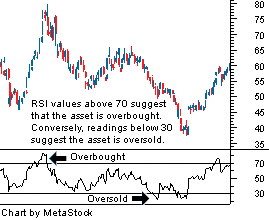The relative strength index (RSI) is another one of the most frequently used and well known momentum indicators in technical analysis. It is used to signal overbought and oversold conditions in a security.
The indicator is plotted between a range of zero to 100 where 100 is the highest overbought condition and zero is the highest oversold condition. The RSI helps to measure the strength of a security's recent up moves compared to the strength of its recent down moves. This helps to indicate whether a security has seen more buying or selling pressure over the trading period.
The standard calculation uses 14 trading periods as the basis for the calculation which can be adjusted to meet the needs of the user. If the trading periods used is lowered then the RSI will be more volatile and is used for shorter term trades.
Calculation of the RSI
 |
How the RSI is used
Like most indicators there are two general ways in which the indicator is used to generate signals - crossovers and divergence. In the case of the RSI, the indicator uses crossovers of its overbought, oversold and centerline.
The first technique is to use overbought and sold lines to generate buy-and-sell signals. In the RSI, the overbought line is typically set at 70 and when the RSI is above this level the security is considered to be overbought. The security is seen as oversold when the RSI is below 30. These values can be adjusted to either increase or decrease the amount of signals that are formed by the RSI. (For more on this topic, check out: Overbought Or Oversold? Use The Relative Strength Index To Find Out)
 |
A buy signal is generated when the RSI breaks the oversold line in an upward direction, which means that it goes from below the oversold line to moving above it. A sell signal is formed when the RSI breaks the overbought line in a downward direction crossing from above the line to below the line. A more conservative approach can be used by setting the overbought and oversold levels at 80 and 20, respectively.
Another crossover technique used in formulating signals is using the centerline (50). This technique is exactly the same as using the overbought and oversold lines to formulate signals. This technique will often form signals after a movement in the direction they are predicting but are used more as a confirmation then a signal compared to the other techniques. A downward trend is confirmed when the RSI crosses from above 50 to below 50. An upward trend is confirmed when the RSI crosses above 50. (For more, see: What is a common strategy traders implement when using the Relative Strength Index (RSI)?)
Divergence can be used to form signals as well. For example, as you can see on the chart of Coca Cola Co. (KO) below, if the RSI is moving in an upward direction and the security is moving in a downward direction it signals to technical traders that buying pressure is increasing and the downtrend may be coming to an end. Divergence can also be used to signal a reversal in an upward trend where the RSI is decreasing signaling increasing selling pressure in an upward trend.

The RSI is a standard component on any basic technical chart. The relative strength indicator focuses on the momentum underlying the security and is a great secondary measure to be used by traders. It is important to note that the RSI is often not used as the sole generation of buy-and-sell signals but used in conjunction with other indicators and chart patterns. (For more, see: Momentum And The Relative Strength Index)
Exploring Oscillators and Indicators: Stochastic Oscillator
-
 Trading
TradingOverbought or Oversold? Use the Relative Strength Index to Find Out
Learn how to use the Relative Strength Index (RSI) for analysis and to generate buy and sell signals. -
 Trading
TradingAre Tech Stocks Primed for a Pullback?
Overbought readings on these key tech assets suggest a significant pullback could be in the cards over the coming weeks/months. -
 Trading
TradingAn Introduction to Oscillators
Find out how this indicator may help improve the average investor's entry and exit points. -
 Trading
TradingThe Top Technical Indicators for Options Trading
Option traders use a number of technical indicators, including the relative strength index, Bollinger bands, Intraday Momentum Index, and Money Flow Index. -
 Trading
TradingThese Energy Stocks Are Poised For A Pop (MPC, CVI)
Falling energy prices have pushed many companies to unjustifiably low levels. Ultra-low readings on RSI indicators suggest that these stocks could be ready for a move higher.



